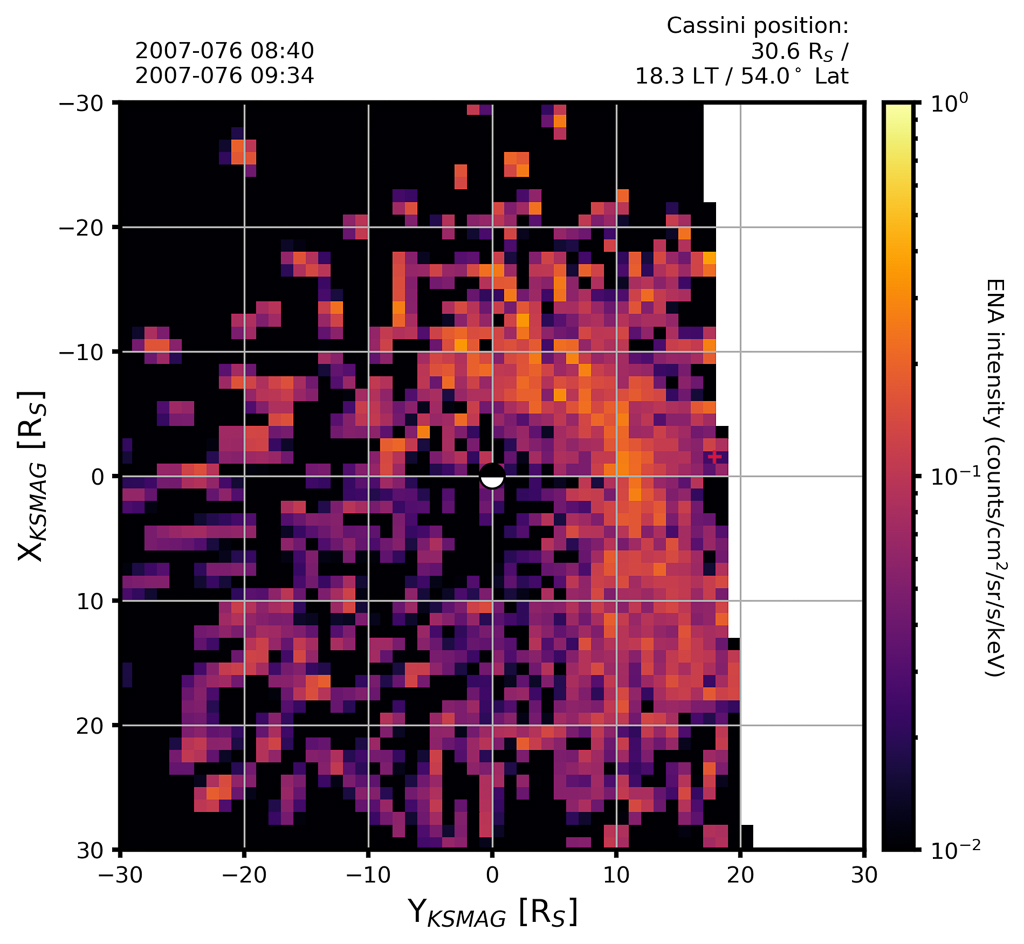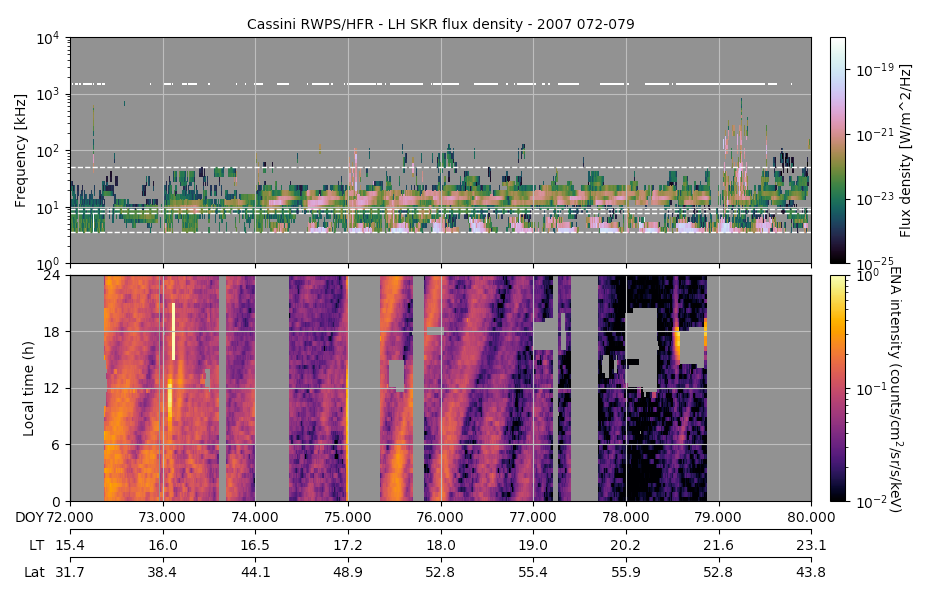Remote sensing Saturn’s global plasma dynamics: testing the relationship between Saturn’s ENA and narrowband SKR emissions.
- 1Lancaster University, UK
- 2Johns Hopkins University Applied Physics Laboratory, USA
- 3Dublin Institute of Advanced Studies, Ireland
- 4Gorilla, Antwerp, Belgium
Saturn’s kilometric radio (SKR) and energetic neutral atom (ENA) emissions are important remote diagnostics of the planet’s magnetospheric dynamics, intensifying during periods of global-scale plasma injection, and displaying characteristic planetary periodicity (e.g. Ye et al., 2011, Kinrade, Bader et al., 2021). Here we focus on the narrowband emissions between 5-40 kHz, thought to originate near density gradients at the edges of the plasma torus (e.g. Gurnett et al., 1981, Ye et al., 2009), and test the hypothesis that narrowband SKR production might be enhanced by inward-moving plasma following global injection events. Global scale ENA signatures have been associated with both 5 and 20 kHz nSKR emissions, particularly at dusk-evening local times (e.g. Wing et al., 2020, Wu et al., 2021) where plasma injections are expected to have moved inwards through the magnetosphere, possibly triggering interchange instabilities (e.g. Mitchell et al., 2015, Azari et al., 2018, Kinrade et al., 2020).

Figure A: A calibrated and re-binned Cassini INCA image of Saturn’s equatorial ENA emission (24-55 keV Hydrogen, X-Y plane). This dataset and the open-source repository location are detailed in Bader & Kinrade, et al. (2020).
We use a new set of calibrated equatorial ENA projections - captured by the Cassini INCA - to test the relationship between Saturn’s ENA and narrowband SKR emissions. The narrowband SKR emission intensity peak often coincides with the rotation of ENA enhancement through the dusk local time sector, complementing the findings of Wing et al. (2020). We test for radial distance dependence by constraining ENA keograms over a set of distances and local time sectors covering the edges of the plasma torus, and quantify the relative timing of nSKR enhancements through correlation of the ENA intensity with flux density in the 5 and 20-40 kHz emission bands. We also observe periods of strong 5 kHz SKR emission when the ENA emission is absent, even during times of favourable viewing, indicating that this relationship is complex (e.g. Wu et al., 2022). These results contribute towards our developing picture of how global plasma injection events can influence Saturn’s inner magnetosphere, linking together two valuable sources of remotely-sensed global emissions, the ENAs and SKR.

Figure B: A re-working of the Wang et al. (2010) narrowband SKR example from 2007 (left-hand SKR polarisation shown in top panel), plus a keogram of the median ENA intensity between 1-20 RS (bottom panel). Some viewing artefacts remain here in this pre-published version of the ENA keogram (DOY 073 and 078), but the persistence of the rotating ENA enhancement over several days is clear. INCA projection / SKR viewing geometry are best on DOY 076 when Cassini was high above the north hemisphere ( > 50º latitude) at a range of ~ 30 RS. The bursts of narrowband SKR coincide with the ENA enhancement rotating through the dusk local time sector.
This work is timely given the expected arrival of the JUICE mission at Jupiter in 2031, which carries an advanced ENA camera. ENA emissions have already been detected from Jupiter and the Io and Europa plasma torii by instruments onboard Cassini and JUNO (e.g. Mauk et al., 2003; 2020), and the arrival of JUICE will provide an opportunity to replicate this analysis, comparing the much-different Jovian ENA and associated radio emissions with those of Saturn’s neutral-dominated magnetosphere.
References
- Azari et al. (2018), Interchange Injections at Saturn: Statistical Survey of Energetic H+Sudden Flux Intensifications, JGR Space Physics, https://doi.org/10.1029/ 2018JA025391.
- Bader, Kinrade et al. (2020), A complete dataset of equatorial projections of Saturn's energetic neutral atom emissions observed by Cassini-INCA, JGR Space Physics, https://doi.org/10.1029/2020JA028908.
- Gurnett et al. (1981), Narrowband electromagnetic emissions from Saturn's magnetosphere, Nature, https://www.nature.com/articles/292733a0.
- Kinrade et al. (2020), Tracking Counterpart Signatures in Saturn's Auroras and ENA Imagery During Large‐Scale Plasma Injection Events, JGR Space Physics, https://doi.org/10.1029/2019JA027542.
- Kinrade, Bader et al. (2021), The Statistical Morphology of Saturn’s Equatorial Energetic Neutral Atom Emission, Geophysical Research Letters, https://doi.org/10.1029/2020GL091595.
- Mauk et al. (2003), Energetic neutral atoms from a trans-Europa gas torus at Jupiter, Nature, https://www.nature.com/articles/nature01431.
- Mauk et al. (2020), Juno Energetic Neutral Atom (ENA) Remote Measurements of Magnetospheric Injection Dynamics in Jupiter's Io Torus Regions, JGR Space Physics, https://doi.org/10.1029/2020JA027964.
- Mitchell et al. (2015), ‘Injection, Interchange, and Reconnection: Energetic Particle Observations in Saturn’s Magnetosphere’ in Magnetotails in the Solar System, https://doi.org/10.1002/9781118842324.ch19.
- Wang et al. (2010), Cassini observations of narrowband radio emissions in Saturn's magnetosphere, JGR Space Physics, https://doi.org/10.1029/2009JA014847.
- Wing et al. (2020), Periodic Narrowband Radio Wave Emissions and Inward Plasma Transport at Saturn's Magnetosphere, The Astronomical Journal, https://doi.org/10.3847/1538-3881/ab818d.
- Wu et al. (2021), Statistical Study on Spatial Distribution and Polarization of Saturn Narrowband Emissions, The Astrophysical Journal, https://doi.org/10.3847/1538-4357/ac0af1.
- Wu et al., (2022), Reflection and Refraction of the L-O Mode 5 kHz Saturn Narrowband Emission by the Magnetosheath, Geophysical Research Letters, https://doi.org/10.1029/2021GL096990.
- Ye et al., (2009), Source locations of narrowband radio emissions detected at Saturn, JGR Space Physics, https://doi.org/10.1029/2008JA013855.
How to cite: Kinrade, J., Badman, S., Paranicas, C., Jackman, C., Moral Pombo, D., O'Dwyer, E., Louis, C., and Bader, A.: Remote sensing Saturn’s global plasma dynamics: testing the relationship between Saturn’s ENA and narrowband SKR emissions., Europlanet Science Congress 2022, Granada, Spain, 18–23 Sep 2022, EPSC2022-1156, https://doi.org/10.5194/epsc2022-1156, 2022.

